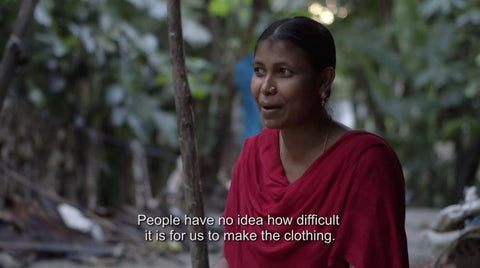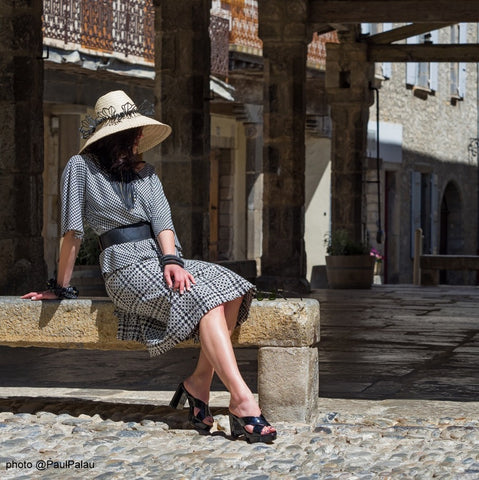
I know I’ve been in the fashion industry most of my life but last night I watched the award winning film/documentary “The True Cost” of fashion and it appalled me! While I recognise the fashion industry has evolved from 2-seasons-a-year to 52 seasons now – yes a new season each week – I wasn’t really aware of just what that exploitation involved. For some time now, I have followed the Fashion Revolution campaign #whomadeyourclothes with interest. Also, I permanently interrogate myself on my own part in this enormous machine that is consumerism. But The True Cost has had a real impact on me. It is a film about the clothes we wear, the people who make them, and the impact the industry is having on our world. It’s about corporate greed versus environmental and human well-being. The reality of the production of fast fashion is truly shocking and it can no longer be acceptable to pretend ignorance.
Each need is as essential as the other
I wrote a blog some time ago about a friend who had complained that a dress she had seen had cost €200 – and in her eyes wasn’t even beautiful. She is used to paying €20. While I understand that we all have financial choices to make, she also needs to look at the overall picture. How many 20euro dresses does she buy and how often? How many times does she wear them? If she took 2 minutes to think it through, and just considered her own personal hourly wage, she would see that there’s clearly something very wrong with a dress, ugly or beautiful, only costing €20. We pay other people for their services because we don’t know how to or don’t want to do it ourselves. If you can’t sew, you pay someone else to make your clothes. If you can’t build a house you employ a builder. If you don’t know the law, you pay a lawyer to help you. And so on. Each need is as essential as the other. Is it OK to pay the person that made your Zara/H&M dress $3/day? Is it ok that some owners of these sweat shops cut corners and jeopardise the safety of their staff such as in the horrific accidents in Bangladesh where more than 1200 workers were killed in one year? The argument that at least they have a job and it could be much worse does not vindicate this $3 salary – in my opinion.
The hidden misery
When I started my business here in France, in 1992, nearly all of the fabrics I bought were French. Now virtually none are. Why? Because they’re cheaper from the East. So all those jobs in French fabric production are now gone. France used to have a thriving garment industry. Nearly all of those jobs have disappeared too because the corporate clothing companies go where the cheapest labour can be found. France and Italy have a thriving underground sweatshop industry alive and kicking, under the radar. Made in France and Made in Italy labels are no indication of honourable provenance. I would love to source more fabrics locally. If you know of someone who is similarly minded, please let me know as I would consider collaborating with them.
Take a stance
The irony of my personal income generation being derived from consumerism is not lost on me, believe me. But I am very clear on my moral stance and my business model is designed around those morals. My fabrics are upcycled stock; that means I do not order fabric to be especially made for me. Instead I buy up ends of lines from over production by other clothing producers. These beautiful fabrics would otherwise have ended up in landfill which is one of the worse bi-products of this consumerism. For example, in Haiti, the influx of charity donated clothes that charity shops can’t sell, means that its own garment industry is now suffering. I continue to choose quality, beautiful fabrics. I then personally create, cut and assemble my own clothing designs to a standard that I believe gives very good value for money. My styles are classic contemporaries that are timeless, in fabrics that will last washing or cleaning for years and years. And I know this because I have such positive feedback from my clients. The concept is to keep them for many years and enjoy mixing them with other old and new items. It’s not about them lasting one season and then throwing them away. My jewellery and homeware collections are sourced from fairly traded suppliers in Southern Africa. The ranges are produced by hand, by skilled crafters. I refuse to resell a product where I am not completely sure of its provenance, circumstances of production or that is in competition with one of my other artisan colleagues in Lagrasse.
So I would like to start a “B Smart" campaign where you can return any of my designs that you no longer wear and they’ll be passed onto others, in need, that would. You can contact me here if you would like to participate.

This beautiful fabric was destined for landfill. There was absolutely nothing wrong with it except the fashion house didn’t need it. Upcycling - part of my "B Smart" campaign.
Also, I would love you to check out these links to learn more about the reality of our fast-fashion obsession. And please let me know what you think. We can all do one tiny thing to help stop the exploitation not only of our fellow human beings but of our poor planet. We, the consumer, are still very powerful.
- The True Cost – the film https://truecostmovie.com/about/ and also on Netflix
- Fashion Revolution https://www.fashionrevolution.org/


6 comments
This is not a shock to me, this exploitation has been going on for decades. I saw it first hand in Java Indonesia in 1991. I visited sweatshops who made Levi jeans, I was appalled to learn back then Levi had their jeans made in Bandang for 1 dollar a piece, shipped to the states where the labels were put on and sold as made in America. I saw young clothes designers exploited by French Couture houses. They traveled to Jakarta bullied these designers into giving over their design promising them a bright future, then dumping them and stealing their designs and passing them off as their own. When I came back then and ranted about this to everyone I met, they thought I was exaggerating or just didn’t want to know . We as consumers are ALL responsible for this. Look at that horrendous Company Primark and Penney’s and they are worth billions because of child sweatshops ! Stop buying cheap crap! Upcycle , buy one good piece a year from a local designer who makes in-house , yes it costs more but it’s unique, classic and is an investment for years !